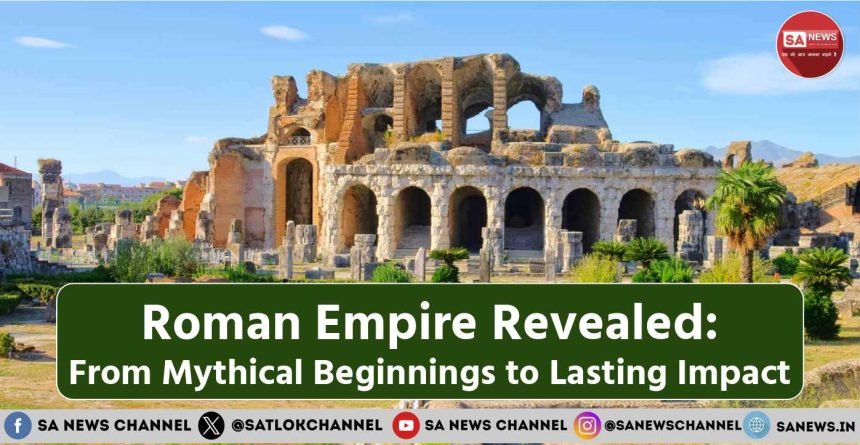Roman Empire History: The Roman Empire, one of the most powerful and influential civilizations in history, left an indelible mark on the world. Spanning over a millennium, from the founding of Rome in 753 BCE to the fall of Constantinople in 1453 CE, the Roman Empire’s history is a rich tapestry of conquest, governance, culture, and innovation. This blog delves deeply into the history of the Roman Empire, exploring its origin, rise, peak, decline, and lasting legacy.
- Key Highlights about Roman Empire History
- Introduction to the Roman Empire History
- The Ascent of the Roman Empire
- Roman Empire History: The Brilliant Period of Rome
- The Roman Republic (509-27 BCE)
- The Structure of the Republic
- Expansion and Conquest
- Internal Struggles and Reforms
- The Fall of the Republic
- Roman Empire History: The Roman Empire (27 BCE-476 CE)
- The Rise of Augustus
- The Julio-Claudian Dynasty (27 BCE-68 CE)
- The Flavian Dynasty (69-96 CE)
- The Nerva-Antonine Dynasty (96-192 CE)
- The Severan Dynasty (193-235 CE)
- Roman Empire History: The Crisis of the Third Century (235-284 CE)
- The Dominate and Late Empire (284-476 CE)
- The Decline of the Western Roman Empire
- The Byzantine Empire (Eastern Roman Empire)
- Roman Empire History: Military Ability of the Roman Empire
- The Tradition of the Roman Empire
- Beyond the Roman Legacy: A Spiritual Perspective
- FAQs on Roman Empire
- 1. How was Rome founded according to legend?
- 2.How did Rome transition from a Republic to an Empire?
- 3.What were the key achievements of the Roman Empire?
- 4. What are some key architectural achievements of the Roman Empire?
- 5. How did the Roman military contribute to the Empire’s expansion?
- 6. What were some factors contributing to the decline of the Roman Empire?
- Connect With Us on the Following Social Media Platforms
Key Highlights about Roman Empire History
- The Roman Empire, from 753 BCE to 1453 CE, profoundly influenced modern governance, culture, and law.
- Legend states Rome was founded by Romulus and Remus, with the transition from republic to empire marked by Julius Caesar and Augustus.
- The empire’s golden age featured major achievements, including the Colosseum and literary works by Virgil and Ovid.
- Expansion through military conquests, like the Punic Wars, led to internal strife and social reforms such as the Gracchi Reforms.
- The Crisis of the Third Century was marked by unstable leadership and external invasions, impacting the empire’s stability.
- Rome’s legacy remains evident in modern legal systems, languages, and cultural practices.
- The rise and fall of the Roman Empire highlight the transient nature of power and the enduring impact of its contributions.
Introduction to the Roman Empire History
The Roman Empire remains as perhaps of history’s most captivating development, known for its wonderful accomplishments and significant effect on the present world. From charming stories of fighters to the many-sided legislative issues of the Senate, the historical backdrop of the Roman Realm offers perpetual interest. By investigating its ascent, magnificence, and inevitable downfall, we can understand how it molded the underpinning of current administration, culture, and regulation.
The Ascent of the Roman Empire
Establishing Fantasies and Early Days
Roman Empire History: As per legend, the city of Rome was established in 753 BC by Romulus. The legendary setting of two siblings, Romulus and Remus, raised by a she-wolf adds profundity to Rome’s initial story. For quite a long time, the Romans embraced this story, which turned into a foundation of their personality.
Republic to Empire Change
At first, Rome was a Republic, represented by elected authorities and a Senate. Notwithstanding, as Rome expanded, it confronted different difficulties, including political debasement and social turmoil. The epic showdown finished in nationwide conflicts, prompting the ascent of Julius Caesar and, in the long run, Augustus, denoting the finish of the Republic and the introduction of the Realm.
■ Also Read: Ancient Civilizations: Here Are The Three Ancient Civilizations
Roman Empire History: The Brilliant Period of Rome
Social Accomplishments
The Roman Realm was a mixture of societies, mixing customs from its various regions. Writing prospered with journalists like Virgil and Ovid, and theory flourished under indifferent masterminds. This period saw the making of basic texts that affected Western writing and thought.
Structural Wonders
Roman Empire History: The building ability of the Roman Realm is apparent in its notorious designs. The Colosseum, an amphitheater seating thousands, empowered gladiatorial games and public scenes. Reservoir conduits exemplified designing accomplishments, providing urban areas with new water. Such designs showed not exclusively Rome’s specialized progression yet additionally its social refinement.
The Roman Republic (509-27 BCE)
The Structure of the Republic
The Roman Republic was a complex system of governance with multiple branches, including:
- The Senate: A body of aristocrats that played a crucial role in decision-making.
- Consuls: Two annually elected officials who served as the executive authority.
- The Assemblies: Various citizen assemblies that voted on laws and elected officials.
Expansion and Conquest
The Republic was marked by rapid territorial expansion. Through a combination of military conquest, alliances, and colonization, Rome extended its influence across the Italian peninsula and beyond. Key events during this period include:
- The Punic Wars (264-146 BCE): A series of conflicts with Carthage that ultimately resulted in Roman dominance over the western Mediterranean.
- The Macedonian Wars (214-148 BCE): Rome’s conflicts with the Hellenistic kingdoms of Greece, which led to the annexation of Greece and the expansion of Roman influence in the eastern Mediterranean.
Internal Struggles and Reforms
Roman Empire History: The expansion of the Republic brought wealth and power but also significant internal challenges. Social and economic inequalities led to tensions between the patricians (aristocratic class) and plebeians (common citizens). Key reforms and events include:
- The Gracchi Reforms (133-121 BCE): Initiated by Tiberius and Gaius Gracchus, these reforms aimed to redistribute land and address economic disparities. Both brothers were ultimately killed, highlighting the violent political climate.
- The Social War (91-88 BCE): A conflict between Rome and its Italian allies over citizenship rights, which resulted in the extension of Roman citizenship to all Italians.
The Fall of the Republic
The final century of the Republic was marked by civil wars and the rise of powerful individuals, such as Julius Caesar. Key events include:
- The First Triumvirate (60 BCE): An informal alliance between Julius Caesar, Pompey, and Crassus that dominated Roman politics.
- Caesar’s Dictatorship (49-44 BCE): After crossing the Rubicon and defeating his rivals, Julius Caesar declared himself dictator for life. His assassination in 44 BCE led to further turmoil.
- The Second Triumvirate (43 BCE): An alliance between Octavian (later Augustus), Mark Antony, and Lepidus, which eventually led to the defeat of their rivals and the end of the Republic.
Roman Empire History: The Roman Empire (27 BCE-476 CE)
The Rise of Augustus
In 27 BCE, Octavian was granted the title of Augustus, marking the beginning of the Roman Empire. Augustus established a new political order, maintaining the outward appearance of the Republic while holding ultimate power. His reign ushered in the Pax Romana (Roman Peace), a period of relative stability and prosperity.
The Julio-Claudian Dynasty (27 BCE-68 CE)
Roman Empire History: The Julio-Claudian dynasty, founded by Augustus, saw both effective and notorious rulers, including:
- Augustus (27 BCE-14 CE): The first emperor who implemented significant administrative and military reforms.
- Tiberius (14-37 CE): Augustus’ stepson who continued his policies but faced increasing unpopularity.
- Caligula (37-41 CE): Known for his erratic and tyrannical behavior.
- Claudius (41-54 CE): An effective ruler who expanded the empire and reformed the bureaucracy.
- Nero (54-68 CE): Famous for his artistic ambitions and alleged tyranny, Nero’s reign ended in revolt and his suicide.
The Flavian Dynasty (69-96 CE)
The Flavian dynasty, founded by Vespasian, restored stability after a period of civil war. Key rulers include:
- Vespasian (69-79 CE): Rebuilt Rome and began construction of the Colosseum.
- Titus (79-81 CE): Completed the Colosseum and dealt with the eruption of Mount Vesuvius.
- Domitian (81-96 CE): His autocratic rule ended with his assassination.
The Nerva-Antonine Dynasty (96-192 CE)
The Nerva-Antonine dynasty is often regarded as a high point of the Roman Empire, marked by capable rulers and relative peace. Key emperors include:
- Nerva (96-98 CE): Initiated the adoptive succession policy.
- Trajan (98-117 CE): Expanded the empire to its greatest territorial extent.
- Hadrian (117-138 CE): Consolidated and fortified the empire’s borders.
- Antoninus Pius (138-161 CE): Oversaw a peaceful and prosperous reign.
- Marcus Aurelius (161-180 CE): Known as the philosopher-king, his reign faced significant military challenges.
- Commodus (180-192 CE): His erratic behavior and assassination led to a period of instability.
The Severan Dynasty (193-235 CE)
The Severan dynasty saw the rise of military rulers who often faced internal and external challenges. Key emperors include:
- Septimius Severus (193-211 CE): Strengthened the military and expanded the empire.
- Caracalla (211-217 CE): Granted Roman citizenship to all free inhabitants of the empire.
- Elagabalus (218-222 CE): His controversial reign ended with his assassination.
- Alexander Severus (222-235 CE): His attempts at reform were cut short by military rebellion.
Roman Empire History: The Crisis of the Third Century (235-284 CE)
This period was marked by political instability, economic decline, and external threats. Key events include:
- Frequent Changes of Emperors: The empire saw over 20 emperors in 50 years, many of whom were overthrown or assassinated.
- Barbarian Invasions: Increased pressure from Germanic tribes and other groups.
- Economic Troubles: Hyperinflation, currency devaluation, and agricultural decline.
The Dominate and Late Empire (284-476 CE)
Diocletian and the Tetrarchy
In 284 CE, Diocletian became emperor and implemented significant reforms to stabilize the empire. He established the Tetrarchy, dividing the empire into four regions, each ruled by a co-emperor. This system aimed to address the empire’s vast size and administrative challenges.
Constantine the Great
Roman Empire History: Constantine the Great, who reigned from 306 to 337 CE, reunified the empire and embraced Christianity, fundamentally transforming Roman society. He founded Constantinople (modern-day Istanbul) as the new capital, which became a center of power for the Eastern Roman Empire.
The Decline of the Western Roman Empire
The Western Roman Empire faced increasing pressure from internal decay and external invasions. Key events include:
- Barbarian Invasions: The empire faced repeated invasions from various groups, including the Visigoths, Vandals, and Huns.
- Economic and Social Issues: Economic decline, corruption, and social unrest weakened the empire.
- The Sack of Rome (410 CE): The Visigoths, led by Alaric, sacked Rome, symbolizing the empire’s vulnerability.
- The Fall of the Western Roman Empire (476 CE): The last Roman emperor, Romulus Augustulus, was deposed by the Germanic chieftain Odoacer, marking the end of the Western Roman Empire.
The Byzantine Empire (Eastern Roman Empire)
Survival and Flourishing
Roman Empire History: The Eastern Roman Empire, known as the Byzantine Empire, continued to thrive for nearly a millennium after the fall of the Western Roman Empire. Key aspects include:
- Justinian the Great (527-565 CE): Justinian sought to reconquer lost western territories and codified Roman law in the Corpus Juris Civilis.
- Cultural and Religious Influence: The Byzantine Empire preserved and transmitted classical knowledge and Christian theology.
- Constantinople: The capital remained a vibrant and powerful center of trade, culture, and politics.
Decline and Fall
The Byzantine Empire faced numerous challenges, including:
- Military Threats: Continuous pressure from Islamic caliphates, Slavic peoples, and later the Ottoman Turks.
- Internal Strife: Political instability, economic troubles, and religious conflicts.
- The Fourth Crusade (1204 CE): The sacking of Constantinople by Western European crusaders severely weakened the empire.
- Fall of Constantinople (1453 CE): The city was finally captured by the Ottoman Turks, marking the end of the Byzantine Empire.
Roman Empire History: Military Ability of the Roman Empire
Key Fights and Systems
The Roman Realm constructed its power through an amazing military. Key fights, for example, the Skirmish of Cannae in 216 BC and the success of Gaul under Julius Caesar displayed animal strength as well as essential virtuoso. The compelling utilization of developments and planned operations permitted Rome to essentially extend its boundaries.
The Job of the Roman Army
Roman Empire History: The Roman army, the foundation of the military, was a carefully coordinated unit lauded for its discipline and preparing. Roman fighters were talented in different battle strategies and assumed an essential part in both safeguard and extension. The army’s versatility in fighting set the norm for armed forces over the entire course of time.
The Tradition of the Roman Empire
Effect on Current Government
The Roman Empire laid the preparation for present day vote based standards. Ideas, for example, the blended government model and governing rules have established in Roman political idea. Numerous contemporary general sets of laws reflect Roman legitimate systems, including common regulation practices.
Social and Semantic Commitments
Roman Empire History: The effect of the Roman Empire on language and culture is significant. Latin, the language of the Romans, advanced into the Sentiment dialects we know today, including Spanish, French, and Italian. Moreover, Roman workmanship, writing, and philosophical ideas keep on affecting Western culture.
Beyond the Roman Legacy: A Spiritual Perspective
The history of the Roman Empire is a tale of ambition, conquest, innovation, and resilience. From its mythical origins and the establishment of the Republic to the grandeur of the Empire and the endurance of the Byzantine state, Rome’s legacy is a testament to its lasting impact on the world. The Roman Empire’s contributions to law, culture, religion, and governance continue to shape our modern world, reminding us of the enduring power of this remarkable civilization.
Yet, despite its immense power and influence, the Roman Empire no longer exists. This reality highlights the transient nature of our world. Regardless of how powerful one may be, everything in this temporary world eventually fades away, including empires and wealth. This impermanence serves as a reminder that true, lasting fulfillment cannot be found in worldly achievements alone.
True permanence can only be found in the eternal abode called Satlok, where there is no death, only everlasting happiness. Achieving this eternal place and experiencing unending joy is possible through the worship of the Almighty God, as described in the holy scriptures of all religions. For a deeper understanding of this spiritual journey, one can read the book “Gyan Ganga” and watch Sant Rampal Ji Maharaj on YouTube.
FAQs on Roman Empire
1. How was Rome founded according to legend?
According to legend, Rome was founded in 753 BC by Romulus, who, along with his brother Remus, was raised by a she-wolf. This story is a foundational myth embraced by the Romans.
2.How did Rome transition from a Republic to an Empire?
Rome transitioned from a Republic to an Empire through political corruption, social unrest, and civil wars, culminating in Julius Caesar’s rise and Augustus’s establishment of the Empire.
3.What were the key achievements of the Roman Empire?
The Roman Empire is known for its architectural marvels like the Colosseum, literary works by Virgil and Ovid, and engineering feats like aqueducts
4. What are some key architectural achievements of the Roman Empire?
Key architectural achievements include the Colosseum, famous for gladiatorial games, and aqueducts that supplied fresh water to cities, showcasing Rome’s technical and cultural sophistication.
5. How did the Roman military contribute to the Empire’s expansion?
The Roman military, known for its discipline and training, played a crucial role in both defense and expansion through strategic battles and advanced combat tactics.
6. What were some factors contributing to the decline of the Roman Empire?
Economic challenges such as overreliance on slave labor, heavy taxation, and inflation, along with external pressures from invading tribes like the Visigoths and Vandals, contributed to the decline.









